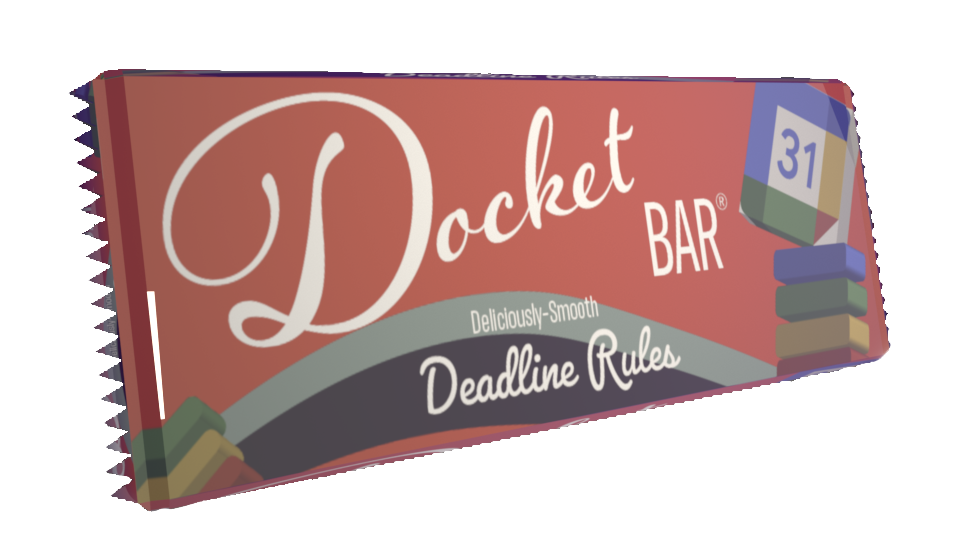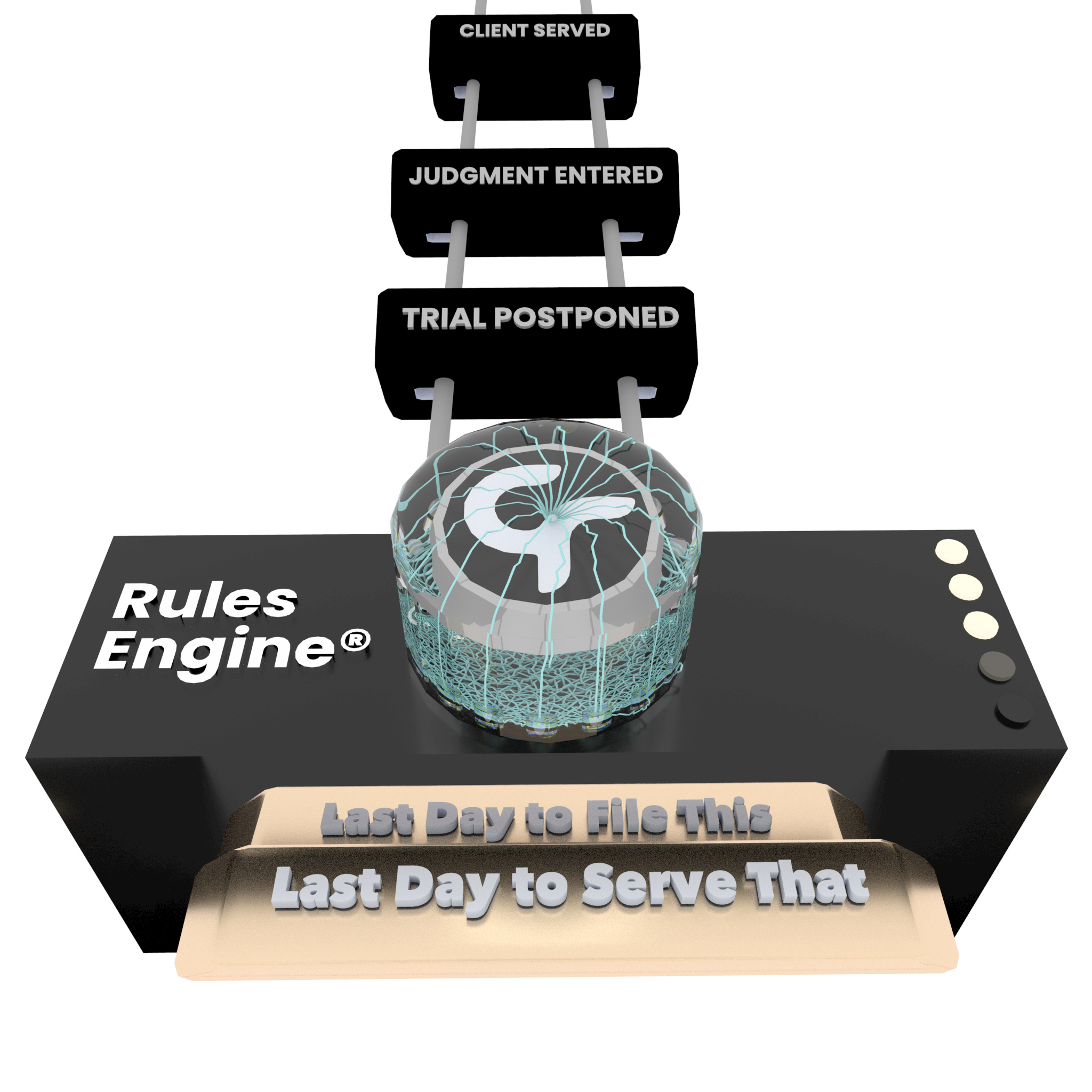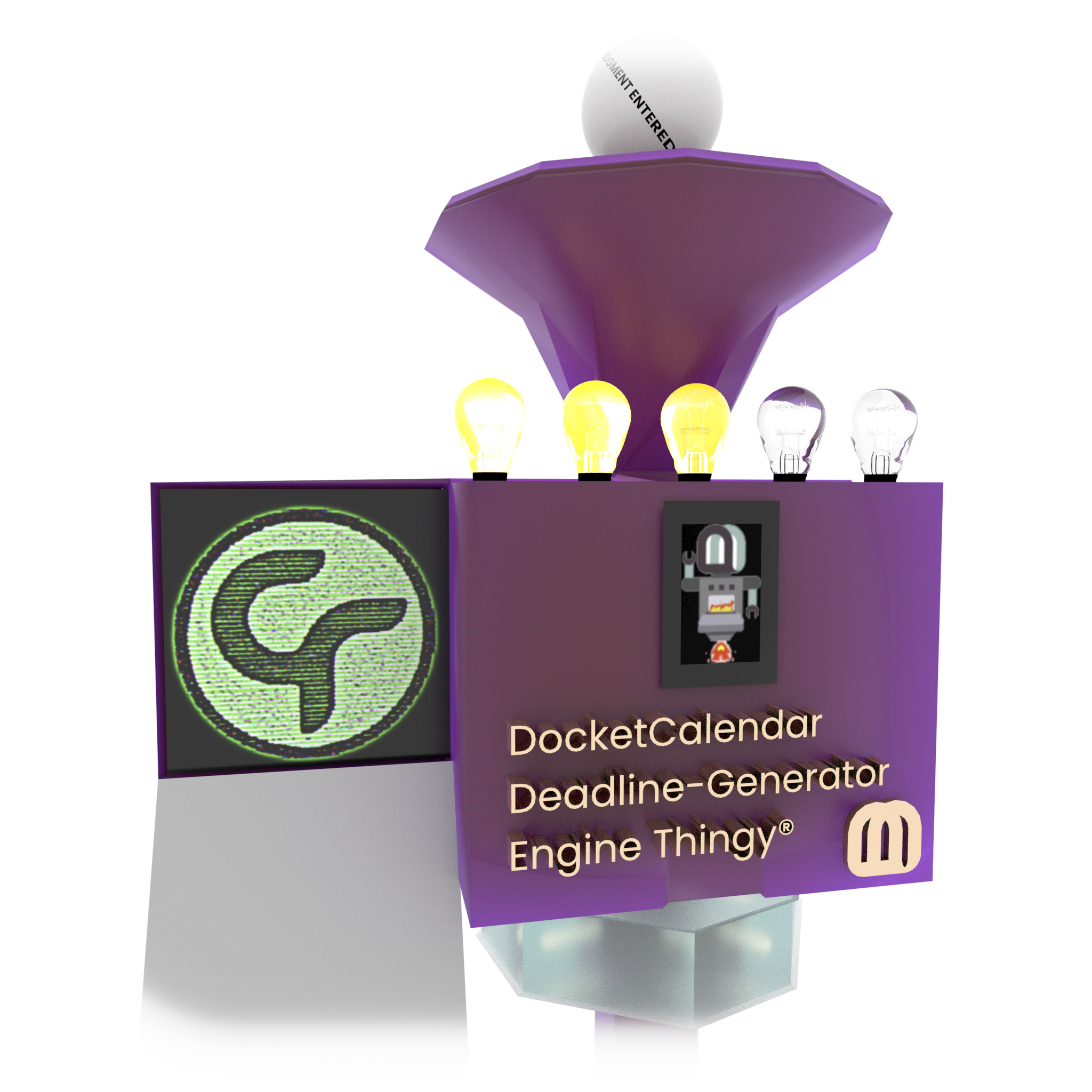

Above and beyond having a great product, a great business model, or even a great team of people working for success, all of which DocketCalendar has, we believe that the timing could not be more perfect.
DocketCalendar offers a solution for law firms of any size to automate a critical aspect of the legal process at a time where automation is more desirable than ever.
The market has been educated, priced out of alternatives, and primed to seek automation during the single largest labor shortage ever.
Why We Believe in
DOCKETCALENDAR
Deadline-Calendaring software has seen significant growth in the legal technology market over the past ten years.

Ten years ago attorneys were hand-counting deadlines, and deadline-calendaring was a niche concept that required market education. Some attorneys could utilize calendaring software within an expensive case management platform, but this was usually reserved for large firms and came at a high cost. In the beginning, selling required introducing prospects to a new technology. Attorneys calculated deadlines manually, and this was considered standard practice.
Today the market realizes that the industry-standard is to automate this process.
When we began selling and marketing CalendarRules for Outlook, the market required education in 100% of the sales interactions. Simply put, the first vacuum cleaner salesman had to educate the consumer on what a vacuum did before they convinced the consumer a broom and dustpan was not efficient.
During this time, three significant products that offer calendaring have entered the content side of the market, one of which is our content provider, CalendarRules. For the past ten years, CalendarRules has partnered with several existing legal software providers, including its new owner Clio and many other companies offering full suite law firm management and automation tools. These programs all have substantial market penetration, and all of them found that offering calendaring as a bolt-on to their applications gave them a competitive advantage. For the past ten years, they have done an excellent job educating the market and opening the very doors that we find easier to knock on because of their efforts.

When the full suite bundled option proves to be too much for the buyer, they come looking for DocketCalendar.
These companies only offer calendaring as an addition to a much larger and expensive program. Besides DocketCalendar, two products provide a stand-alone calendaring solution, both of which we have consistently been able to win against in direct competition for new business. Although not unique to the legal software industry, consolidation of niche companies as investor acquisitions has created a predictable opportunity. Many of these small and niche companies new owners did predictably raise their prices aggressively on existing customers. Customers who had been loyal buyers, often since the founding company’s beginning, are now finding themselves in a literal panic to replace a once affordable and indispensable tool that is suddenly cost-prohibitive.
This aggressive cost gouging and product bundling has driven many dormant and satisfied customers out into the market to shop. We began to see the signs of this strategy emerging in 2018. In these past few years, the only tactic that these companies have deployed, again predictably, is to offer slightly less drastic price increases with multi-year agreements.
Most firms require months and sometimes a year or more to make a significant product change, and for many firms, the news about price increases came at renewal time with little or no time to properly vet a replacement. After speaking to many of these people, we estimate about 70% of that market opted to renew in multi-year commitments.
The significance of this cannot be understated. These companies were often pressured into long-term contract, which openly complained about the limitations of the products they used. This gave us valuable market insight, and in many ways, time to develop the perfect product when they are ready to revisit switching.
Though these factors alone create a significant and compelling opportunity, Covid has had a considerable impact on the legal market as well. The typical small or medium-sized law firm relies on the labor of well-trained paralegals and legal assistants. The legal industry has not been immune to the staffing problems that are well documented. Unlike many companies that can hire and train inexperienced workers, the legal market requires at least some legal education or experience, so the effects of the shortages are amplified.
Practice Areas
IN OUR
Target Market
Bankruptcy
Civil Practice
Civil Rights
Class Action
Construction Law
Consumer Law
Debtor & Creditor
Family Law
Fraud & Deceit
Insurance Defense
Labor & Employment
Legal Malpractice
Libel, Slander, & Defamation
Litigation
Medical Malpractice
Negligence
Occupational Safety & Health
Personal Injury
Premisis Liability
Probate
Products Liability
Professional Liability
Torts
Toxic Torts
The U.S. attorney market comprises an estimated 1.33M lawyers within 455K law firms. We’ve identified 58,455 law firms by practice area that are within our target market.
In the next 36 months, we project we will convert 150 of the current 200 CalendarRules for Outlook clients into DocketCalendar clients with user pricing as a component of their recurring subscription. Additionally, we project closing deals with 520 new clients with an average monthly value of $90 per client. Using sales data collected from our current client acquisition process, we project we will accomplish this goal by the end of 2024. At this time, DocketCalendar will produce $585K in annual recurring revenue with annual operating expenses of $585K.
We project that we will operate at a loss for the next 30-36 months, requiring a total investment of $500K, including investments made to date. As sales increase, the operation loss will decrease each month until we reach a point of breakeven.
To quantify our market share at 1M in recurring revenue DocketCalendar must maintain a recurring customer base of roughly 1,200 clients with 3,600 users. With a direct market of 58,455 law firms we require a meager 2% market penetration to achieve our objective. Solo practitioners as seen in the table below represent another significant market segment.
Our markets and what its gonna take to hit a million...
Attorney's & Lawyers
Law Firms
Mid-to-Small Size Law Firms
(under 25 lawyers)
Solo Practitioners
DocketCalendar is a web application that calculates event dates based on court rules content that it receives through court rules provider, CalendarRules, now part of Clio. DocketCalendar began as a CalendarRules branded Microsoft Add-in that provides an application screen for users to calculate rules-based deadlines and create Microsoft Outlook events automatically. The program only calculates the events and contains no client management components typically found in most law firm tools. Any relevant client data needs to be manually input each time the program is used. Despite this program limitation, the CalendarRules branded Microsoft Add-In found a niche market of small and medium-sized firms that fall into the following groups:

DocketCalendar takes the service we currently provide and gives the users the simple features they routinely ask for without attempting to become a full-service case management system. DocketCalendar, the Microsoft Add-In, requires installation and IT support which is time-consuming and expensive. Because the program is manually installed, it requires third-party software support to troubleshoot any issues that may arise. The web-based program can be connected to Google or Exchange 365 without IT involvement. The program support is handled without IT, making the trial processes faster and the client training and onboarding simpler. The program now offers the users case-specific data that combines with the rules-based calculations to create more efficiency in the calendaring process. DocketCalendar also provides the user with robust reporting and records management tools all online.
We greatly enhanced the level of functional control and detail that the program provides to the user. These enhancements include; fully customizable event titles, editable text fields that place common data in all key data points on grouped events, and many more features. The Tools application will have arrived at MVP after completing Microsoft Graph integration. Once we complete Graph, we will turn our attention to three remaining upgrades to the shopping cart: annual pricing, matter pricing, and discounts.
During the initial 12-month building stage, we have identified, designed, and built 33 new features into the application and 68 feature upgrades. At this stage, we have identified further development projects to enhance the Tools application, which will allow us to offer a two or three-tier pricing model.
Overall, we have identified 60 additional development projects. These have been divided into three groups.:
- Approved for current or next build cycle
- Approved for development – To be sourced
- On hold until next-generation – New Code Build
These development initiatives are covered in more detail in the appendix.
The current application is built in PHP with a WordPress head. Once we have completed our MVP product, we will evaluate the cost of bolting more features onto the current application against the longer-term objective of upgrading the core application language to build a more robust and scalable next-generation application. Our investment in Azure will give us the necessary scalability to get us through our first 500 to 1000 clients. We expect that in order to grow beyond this level, we will need to perform a stress test to know if our current application presents any challenges at scale. This will give us the necessary information to decide if it makes sense to evaluate a new code build and halt the further development of the 1st generation.

In the interim, we intend to continue development with Clarion through the completion of the MVP cart and some small scope functional improvements before closing the hood on the Tools Application. At this time, we will decide which of the following options we will proceed with:
- Continue with the development of the current application
- Halt development and maintain application
- Begin Development of a new application
Our current application is sufficiently robust to take us through the start-up phase. Additional development will create the opportunity to grow beyond the start-up phase. A number of the new features identified in our development plan will enable us to offer varying levels of functionality with tiered pricing; while this is not required to meet the objectives in our business plan, it provides us with additional pathways to revenue growth.Taking the initial framework of our working shopping cart and Google application, we took on a substantial amount of setup getting our web apps communicating with Azure and LawPay. Once the initial connections were made, we began a complete redesign of how DocketCalendar interacts with multiple Calendars. We stripped out the functions built to work with invite protocol and reconnected the program to all multi-calendar environments with direct-write shared calendar access.
LawToolBox and Deadlines.com both offer rules-based calendaring that integrates with Outlook. They provide a similar feature level in that they integrate with calendars and calculate deadlines and are priced similarly to our application.
We go up against LawToolBox and Deadlines.com regularly. It is expected that prospects will compare the three interfaces, functionalities, and pricing. We do not find pricing to be the deciding factor most of the time. LTB offers matter-based pricing, and this model fits users who have infrequent need for litigation-related deadlines. We plan to provide matter-based pricing in 2022. When users compare the core product function, calculating deadlines, DocketCalendar wins against both competitors for various reasons.

Non-Affiliated: Time Matters, Rocket Matter, Leap, Cosmolex, Legal Files, Abacus Law, Amicus Attorney, Firm Central, PracticePanther, Actionstep, Aderant Compulaw, ALN
These products all contain a calendaring component as a single feature in a larger full suite offering, including case and client management, time and billing, conflicts, legal research, and more. Law firms seek these bundled products to consolidate all firm functions and are not in direct competition. Someone looking for this level of integration would not seek a calendaring solution only.
Affiliated: Advologix, BEC Docket Enterprise, Caseflow, Casepeer, Caseroads, Clio, CourtAlert, CoyoteAnalytics, Cycom, DocketAlarm, HoudiniEsq, JuraLaw, Lawbase, LegalFiles, LegalServer, LSS, Litify, MA 3000, meruscase, mycase, SimpleLaw.com, SmartAdvocate, Tabs3 These products are the same as the non-affiliated, except that they all integrate with the same rules provider, CalendarRules. When a prospect or customer from one of these companies looks for a calendaring alternative, DocketCalendar is the referral of choice. In turn, we refer our more advanced full-featured service prospects to CalendarRules.
These products are the same as the non-affiliated, except that they all integrate with the same rules provider, CalendarRules. When a prospect or customer from one of these companies looks for a calendaring alternative, DocketCalendar is the referral of choice. In turn, we refer our more advanced full-featured service prospects to CalendarRules.
Why we’re better

More Granular Trigger and Deadline detail

Better User Interface

Superior Training and Support
Marketing: Ground-Zero
To make the best of every marketing dollar spent, we emphasized ensuring our customer data is accurate at the intake level. The CRM and data we absorbed from CalendarRules sat within the confines of our existing CRM at that time, SalesForce. SalesForce limitations prevented us from migrating over data that would power our automation and marketing goals and did not offer all the automation possibilities we knew we needed to exploit to achieve our objectives.
In May, we switched to Hubspot, allowing us to accomplish more out-of-the-box. After taking the time to comb through every record and manually import them into our new system, we began to set up processes rooted in automation that would allow our sales team to increase their day-to-day productivity. Our productivity rate continues to increase as we introduce new and better tools to the team and continue to grow along with the current technological automation boom. Automated processes added in the past year include client bookings via meeting link, automated trial start and lead email sequences, among others which simplify and, in some cases, eliminate many of the classic day-to-day salesperson pain points.
Before spending a dollar on advertising or SEO optimization, it was imperative to have a strong foundation of captivating and clean marketing material. We redesigned our web page from the ground up, which includes a myriad of tools and resources designed to attract potential customers and significant user-experience improvements for new clients who need quick access to product operation guides and resources.
Marketing: Long-Term
The CalendarRules name brought an established level of brand recognition, which helped ease inbound marketing. Ensuring that we had the tools to exploit our association with a well-known brand while building our brand was a necessary first step in our marketing game plan.

At a high-level, our long-term marketing goals center around establishing DocketCalendar as a thought-leader for deadline calendaring in the legal realm. Being a new name in an industry full of tenured products from companies such as Westlaw and Lexis Nexis meant that our core brand-awareness strategy needed to be established early on to reap its benefits two or even three years into the future. To do this, we curated a list of roughly 60 search queries that relate to deadline calendaring and contain the type of vernacular a lawyer might use if they were seeking out a deadline-calendaring solution via Google Search. These terms are linked to a Google Search Ad, which appears at the top of the search page. These terms and our bidding strategy against them require intermittent tweaking based on the data we receive to optimize our output for the cost of running the ads. Spotlighting the best terms to invest in requires continual evaluation to allow for the nuances between very similar search queries (see chart above).
For the leads that do convert (customarily by filling out a form on our site), we supply blog articles delivered via curated email nurture campaigns, which help sustain awareness of our product on a lead-by-lead basis. We can also capture a lead profile that gives us a picture of our ideal marketing prospect. This information is fed back into the system to improve our advertising precision.
Marketing: Ads
Given the newness of our brand, we focused our approach on curating a strong marketing strategy outside of SEO optimization. With our limited budget, we decided to utilize known platforms where content feeds can create brand awareness. Our initial testing yielded more palpable results from Facebook compared to LinkedIn or Google Ads. As we see the results from each campaign, we can further refine our target market. We see incremental improvements in our results with each ad and are now receiving more than five leads via Facebook per week.

To achieve this, we started by creating a “lookalike” audience based on our current contact list and those who have visited our website. This resulted in a Facebook audience of roughly 500,000 accounts that we continue to refine further by re-snapshotting our lookalike audience with the new leads that come in so that our ad audience becomes progressively more curated over time.
Tracking codes on our website help us track how visitors interact with our landing pages. Our communication with Facebook’s ad network allows us to take advantage of “remarketing” (or retargeting) to display our ads to relevant parties who have never heard of DocketCalendar.
These tools give us a solid foundation to collect the data necessary to create truly actionable market tactics.
We hold patience and flexibility in high esteem; a malleable mindset has been our approach from the beginning, and remaining forward-thinking in practice carries more weight than ever, given how technological advances can change an industry’s marketable landscape overnight.

To achieve our goals, we must; increase sales production, support and retain existing clients, and improve our overall efficiency.
Our past sales and support process had been 100% manual. The current plan is to remain at our existing headcount for the foreseeable future and leverage sales and support automation to increase productivity. We have identified best practices and significant opportunities to increase production without relying on additional personnel. To this end, we have also applied carefully designed metrics to ensure that our objectives are attainable.
To understand our projections, we first need to establish the baseline from our measurements drawn. The baseline sales process and account management process are entirely manual. A visit to our website, form submission, or inquiry would not generate an automated response. Following up with a prospect required manually entering their information to our CRM as a lead, and email correspondence would be sent manually.
All new onboarding and client training, including new hire training and web demos, had been manual. Scheduling meetings was done the good old-fashioned way, calling and emailing back and forth to find an agreeable time. This was followed by manual meeting creation of an invitation and emailing clients or prospects who forgot about the scheduled call.

Reviewing our past process revealed that the limits of our manual procedures frequently overshadowed sales focus. Client support and new trial prospect support taking precedent over prospecting resulted in predictable fluctuations in production.
Absent any improvements; we measured the most critical factor in managing the finite number of people we have to execute the necessary work, time. Sales are typically evaluated by metrics that can be measured. How many sales calls, demonstrations and follow-ups were made. Even the most advanced CRM systems do a sub-par job of capturing this data in a significant way. The key focus points in these systems are time in the sales cycle and the number of “touches” or calls. These metrics fail to accurately measure the time a salesperson engaged in a single prospect. A 2-hour prospect call followed by a complex and lengthy email can take far more time than 15 calls to a non-receptive prospect.
Capturing all sales activity, calls, demonstrations, emails, support, etc., allows us to count the number of interactions on which we place minimal value, and more precisely, estimate the amount of time spent working with each prospect when they become a customer. Reviewing the details available to us, we have determined that our average time spent closing a sale is 3.85 hours. We have emphasized conservative estimation, so we are rounding up to 4 hours per sale for our purposes.
We have also determined that while we have a very high close ratio on prospects who engage fully in a trial of DocketCalendar, we spend almost an equal amount of time developing prospects to the point where they are disqualified from moving forward. While the ratio of expected sales activity past the initial prospecting stage yields a higher number of sales than non-sales, we conservatively estimate that 4 hours of sales effort goes into the disqualified sales opportunities as well. In other words, for every 4 hours we spend producing a sale, we spend another 4 hours working on another opportunity that does not close. We are cumulatively engaged in 8 hours of sales activity to make a single sale bundled together.
Using a very basic method of tracking expected results from cold call prospecting, we expect that we can predictably produce 1.5 sales for every 100 sales prospecting calls we make. We expect to reach ten prospects who will accept information, yield five demo calls, three trials, and 1.5 sales conversions per 100 calls. Keeping with our conservative estimates, we are building into our plan that 100 sales prospecting calls will take 16 hours of effort to produce the five engaged demos that lead to our 1.5 sales. Our baseline process required a total of 24 hours, between prospecting and sales activity, to close 1.5 sales
During our first six months in operation, our primary focus was to identify every aspect of sales, support, training, and marketing that automation can improve. Automation in these areas will enroll prospects into an engagement cycle. Providing better introduction materials, including web-accessible presentations, enhanced user guides to make it easier for clients and prospects to self-train, and quality video training content that addresses all of our known bottlenecks regarding training issues.

Additionally, we took a significant amount of effort to evaluate our CRM with one primary objective, leveraging all known new and advanced marketing techniques with a specific focus on CRM integration and marketing automation. A simple example of this would be that as of today, when a prospect fills out an information form, a new lead is created, and an automatic email reply is sent to the client with information, including links to schedule a web demonstration automatically. Meetings are automatically booked, and reminders are sent to meeting recipients, which has resulted in a far higher first booked meeting kept ratio than we have historically had.
Our position has long been that the length of the trial period is irrelevant to the end goal. Contrary to the prevailing belief that creating urgency produces results, this technique does not work with the attorney market. Rather than focus on a helicopter approach to each prospect, we design our sales approach to be open-ended to align with the most significant factor that has been attributed to successful startups, timing. While our philosophy of patience is not changing, automated follow-up and nurture campaigns will allow us to stay engaged with those prospects without requiring effort from the sales team.
With improved support documentation, we have successfully reduced the amount of time spent working with clients on support issues. We have deployed internally focused assets and external assets on client support and removed the sales team’s focus on client support. Additionally, our new online program has proven to require almost no technical support, so we anticipate lower support requirements with new clients. With automated training materials, we expect to remove as much as 50% of the second stage training and onboarding that presently takes place through one-to-one live training calls.
By the 3rd quarter of 2022, we will have doubled our sales efficiency. Where we presently produce 1.5 sales for every 24 hours of sales effort, we project we will produce three sales once we have fully deployed all our automation and marketing assets.